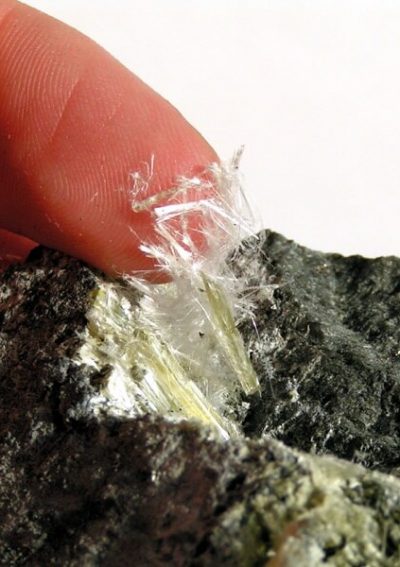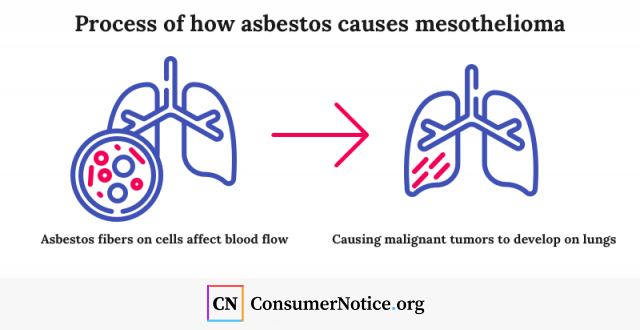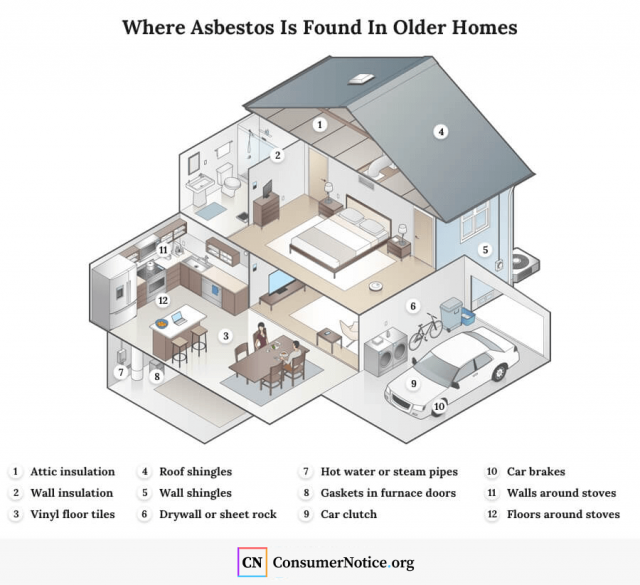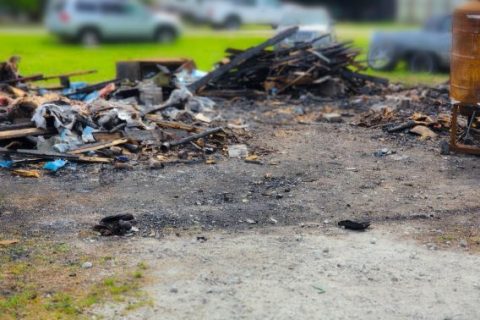Asbestos
Though asbestos has been banned for most uses for three decades, the cancer-causing mineral substance is still present in older buildings and industrial products. And people may face health risks for as long as 70 years after asbestos exposure.

Asbestos was once a popular material in construction and manufacturing because of its heat resistance. But its link to lung cancer, mesothelioma and other serious diseases led to the United States to ban five uses along with any new uses initiated after August 25, 1989. However, the United States continues to import and use asbestos, and the mineral substance can still be found in products Americans use every day.
While the restrictions have reduced the chances of exposure from new uses of asbestos, the mineral substance may remain in older buildings or machinery. And people exposed to it even decades ago are still at risk of developing serious and even deadly medical conditions.
The World Health Organization estimates that roughly 125 million people in the world are exposed to asbestos at the workplace, and globally, about 107,000 people die from asbestos exposure every year. In the United States, about 2,500 people died from asbestos-related mesothelioma annually.
What Is Asbestos?
Asbestos is the name for a group of six different minerals that occur naturally as bundles of fiber. The fibers can be separated into threads and woven into products that resist heat and fire. Asbestos fibers also do not conduct electricity. These qualities made it an attractive material for scores of building and industrial applications.
It has been in use in the United States since the late 1800s. World War II greatly expanded its use as it was incorporated in ships, military equipment and buildings.
Following the war, the construction industry further amplified its use to strengthen cement and plastic and used it in building materials for roofs, floors and walls.
The automotive industry relied on its heat resistant properties for gaskets and brake pads. The shipbuilding industry used it for insulation around boilers and pipes.
Asbestos-Related Diseases
Asbestos fibers can be inhaled if they are disturbed. Once inhaled, they can become trapped in the lungs. The fibers can cause scarring and inflammation, leading to several serious health conditions that may not show up until years or even decades after the exposure.
United States and international health and environmental agencies classify asbestos as a carcinogen, or a substance known to cause cancer. The International Agency for Research on Cancer, for example, determined asbestos causes mesothelioma and cancer of the lung, larynx and ovary.
In addition, it may cause other serious and permanent lung conditions.
Mesothelioma
Mesothelioma is a rare cancer that affects the membranes that line the chest and abdominal cavities and the lungs. It may also affect membranes around other internal organs.
Though rare, mesothelioma is still the most common type of asbestos-related cancer. Mesothelioma may not be diagnosed until 20 to 71 years after exposure to asbestos, according to the U.S. Centers for Disease Control and Prevention.

Lung Cancer
Researchers estimate that between 4 percent and 12 percent of lung cancer cases are related to working around asbestos, according the U.S. Agency for Toxic Substances and Disease Registry.
Smoking can increase the risk of lung cancer from asbestos. Most asbestos-related lung cancer cases involve people who both smoked and were exposed to asbestos fibers.
Asbestosis
Asbestosis is an inflammatory condition that can cause permanent lung damage. People with asbestosis may experience coughing and shortness of breath.
It usually occurs in people who had heavy asbestos exposure on the job, and it develops in about half of people who work around asbestos.
Severe asbestosis can lead to respiratory failure over 10 to 20 years. And many people who develop asbestosis die of other asbestos-related conditions, including lung cancer and mesothelioma.
Pleural Diseases
Asbestos exposure can cause non-cancerous conditions involving the pleural membranes that surround the lungs. It can lead to pleural thickening and plaques. And fluids may collect between the lungs and chest cavity, a disorder called pleural effusion.
While these conditions are usually not fatal, some evidence suggests people with pleural disease are at a higher risk of lung cancer. Pleural abnormalities may not show up until 10 to 30 years after asbestos exposure.
Exposure to Asbestos
Public health authorities warn that there is no safe level of asbestos exposure. Some people have developed mesothelioma after just a few days of exposure to asbestos, according to the U.S. Occupational Safety and Health Administration.
Virtually everyone will be exposed to asbestos at some point in their life. Air, water and soil all contain low levels of the substance. But most people won’t suffer complications from minimal exposure.
Asbestos-related illnesses tend to affect people who’ve been exposed to the substance on a regular basis, usually at work.
Jobs with the greatest risk of asbestos exposure include:
- Asbestos miners and millers
- Asbestos removal workers
- Autoworkers and mechanics
- Demolition workers
- Drywall removers
- Firefighters
- Insulation installers and removers
- Manufacturers of asbestos products
- Shipbuilders
- Veterans
But some people have developed asbestos-related illnesses without working around the substance, according to the California Office of Environmental Health Hazard Assessment. People have suffered higher exposure because they lived with someone who worked around asbestos, or because they lived near asbestos mines or factories.
Places You May Find Asbestos
Older buildings may still contain asbestos products. These may include attic and wall insulation, vinyl floor tiles or shingles used on the roof and outer walls. Asbestos may also be in drywall or sheet rock used for interior walls.
Hot water or steam pipes may be coated with asbestos-based materials or wrapped in an asbestos insulation blanket. Gaskets in furnace doors may contain asbestos. Walls and floors around wood-burning stoves may be protected with paper, boards or cement treated with it.

You may also find asbestos in some heat-resistant fabrics or in aftermarket automobile clutch and brake pads.
You can’t usually tell if a material contains asbestos just by looking at it. And disturbing asbestos fibers can release them into the air, potentially exposing you to health risks.
What to Do If You Suspect Asbestos in Your Home
Materials containing asbestos are not likely dangerous so long as they are not damaged or disturbed. As long as the fibers are contained, they aren’t likely to be inhaled in large enough numbers to cause harm.
If you are planning on remodeling or making repairs to your home and suspect it may disturb asbestos-based materials, you should have a licensed asbestos professional test for asbestos first. You should also seek out a professional if you spot material that’s damage and you suspect it may contain asbestos.
You should never attempt to break off a piece to sample or try to remove suspected asbestos-containing material on your own.
Asbestos in Schools
Every school in the United States must be inspected for asbestos unless the architect or project engineer has certified no asbestos-containing materials were used to build it. But even if an inspection finds asbestos in the building, it may be safer to leave it alone.
This is called “managing in place.” The materials are generally safe so long as they don’t release asbestos fibers. Sometimes, removing the materials can stir up fibers and create a health risk for students, teachers and others in the school building. However, schools are required to remove, maintain or take other appropriate actions if the materials deteriorate or are damaged.
Schools are required to have an asbestos management plan that outlines what they will do to reduce exposure risks if asbestos poses a hazard. The plan must also document the location of asbestos, and what steps the school is taking to repair or remove the materials. Anyone may request a copy of the report from the school administration, which is required to provide a copy within five working days of the request.
The rule applies to all public and non-profit elementary and secondary schools in the United States.
Asbestos and Talc
Talc is the softest mineral on earth and is used in talcum powder, cosmetics and other products. It’s mined from clay and often is found near asbestos deposits. Geologists warn the close proximity can lead to asbestos-contaminated talc.
As of April 2019, nearly 12,000 people had filed lawsuits against Johnson & Johnson claiming the company’s talcum powder caused cancer. Other manufacturers also face talcum powder lawsuits.

Women claim in their lawsuits that they developed ovarian cancer after years of using talc for feminine hygiene, a use heavily marketed by talcum powder makers for decades. The companies claim their products don’t contain asbestos. But researchers who examined samples for those suing the companies claim to have detected asbestos in the products.
In March 2019, the U.S. Food and Drug Administration announced that it had found asbestos in makeup sold by Claire’s and Justice retailers. Claire’s removed the affected makeup and said in a statement it was “also removing any remaining talc-based cosmetic products.” The Justice product that tested positive for asbestos had already been recalled in 2017.
Talc was once used in some Crayola and Prang crayons. Traces of asbestos were found in some of these. In June 2000, the U.S. Consumer Product Safety Commission determined the risk to children was “so small it is scientifically insignificant.” Even so, United States crayon manufacturers eliminated talc from all their products.
Talc was once applied to surgical gloves and condoms. But manufacturers quit using it after the FDA raised health safety concerns.
23 Cited Research Articles
Consumernotice.org adheres to the highest ethical standards for content production and references only credible sources of information, including government reports, interviews with experts, highly regarded nonprofit organizations, peer-reviewed journals, court records and academic organizations. You can learn more about our dedication to relevance, accuracy and transparency by reading our editorial policy.
- Agency for Toxic Substances & Disease Registry. (2016, August 9). Asbestos Toxicity; What Respiratory Conditions Are Associated With Asbestos? Retrieved from https://www.atsdr.cdc.gov/csem/csem.asp?csem=29&po=11
- Agency for Toxic Substances and Disease Registry. (2016, November 3). Health Effects of Asbestos. Retrieved from https://www.atsdr.cdc.gov/asbestos/health_effects_asbestos.html#
- American Cancer Society. (2018, December 4). Talcum Powder and Cancer. Retrieved from https://www.cancer.org/cancer/cancer-causes/talcum-powder-and-cancer.html
- California Office of Environmental Health Hazard Assessment. (2000, May 8). Asbestos Fact Sheet – Information on Health Risks from Exposures to Asbestos. Retrieved from https://oehha.ca.gov/air/asbestos-fact-sheet-information-health-risks-exposures-asbestos
- Claire’s. (2019, March 6). Statement. Twitter. Retrieved from https://twitter.com/claires/status/1103303881776422912
- Furuya, S., et al. (2018, May 16). Global Asbestos Disaster. International Journal of Environmental Research and Public Health. Retrieved from https://www.ncbi.nlm.nih.gov/pmc/articles/PMC5982039/
- Girion, L. (2018, December 14). Johnson & Johnson Knew for Decades that Asbestos Lurked in Its Baby Powder. Reuters. Retrieved from https://www.reuters.com/investigates/special-report/johnsonandjohnson-cancer/
- International Agency for Research on Cancer. (2012). Arsenic, metals, fibres, and dusts; Volume 100 C; A review of human carcinogens. Retrieved from https://monographs.iarc.fr/wp-content/uploads/2018/06/mono100C.pdf
- Kasper, C.S. and Chandler, P.J. (1995, March 15). Possible Morbidity in Women from Talc on Condoms. JAMA. Retrieved from https://jamanetwork.com/journals/jama/article-abstract/387473
- Kennedy, M. (2019, March 6). FDA Says It Found Asbestos in Makeup at Claire’s. NPR. Retrieved from https://www.npr.org/2019/03/06/700830418/fda-says-it-found-asbestos-in-childrens-makeup-at-claire-s
- Molina, DK and DiMaio, V.J. (2012, December). Normal Organ Weights in Men: Part II – The Brain, Lungs, Liver, Spleen, and Kidneys. American Journal of Forensic Medicine and Pathology. Retrieved from https://www.ncbi.nlm.nih.gov/pubmed/22182984
- National Cancer Institute. (2017, June 7). Asbestos Exposure and Cancer Risk. Retrieved from https://www.cancer.gov/about-cancer/causes-prevention/risk/substances/asbestos/asbestos-fact-sheet#q3
- Rabin, R.C. (2018, December 14). What Is Talc, Where Is it Used and Why Is Asbestos a Concern? The New York Times. Retrieved from https://www.nytimes.com/2018/12/14/business/talc-asbestos-powder-facts.html
- Ramazzini, C. (2016, March 31). The Global Health Dimensions of Asbestos and Asbestos-Related Diseases. Journal of Occupational Health. Retrieved from https://www.ncbi.nlm.nih.gov/pmc/articles/PMC5356970/
- U.S. Centers for Disease Control and Prevention. (2017, August 1). Malignant Mesothelioma Mortality – United States, 1999-2015. Retrieved from https://www.cdc.gov/mmwr/volumes/66/wr/mm6608a3.htm
- U.S. Consumer Product Safety Commission. (2000, June 13). CPSC Releases Test Results on Crayons, Industry to Reformulate. Retrieved from https://www.cpsc.gov/content/cpsc-releases-test-results-on-crayons-industry-to-reformulate
- U.S. Department of Labor. (n.d.). Asbestos. Occupational Safety and Health Administration. Retrieved from https://www.osha.gov/asbestos
- U.S. Environmental Protection Agency. (n.d.). Asbestos Frequently Asked Questions. Retrieved from https://www.epa.gov/sites/production/files/documents/asbestosfaqs_0.pdf
- U.S. Environmental Protection Agency. (n.d.). EPA Actions to Protect the Public from Exposure to Asbestos. Retrieved from https://www.epa.gov/asbestos/epa-actions-protect-public-exposure-asbestos
- U.S. Environmental Protection Agency. (n.d.). Learn About Asbestos. Retrieved from https://www.epa.gov/asbestos/learn-about-asbestos
- U.S. Food and Drug Administration. (2019, March 5). Statement from FDA Commissioner Scott Gottlieb, M.D., and Susan Mayne, Ph.D., Director Of The Center For Food Safety And Applied Nutrition, on Tests Confirming a 2017 Finding of Asbestos Contamination in Certain Cosmetic Products and New Steps that FDA Is Pursuing to Improve Cosmetics Safety. Retrieved from https://www.fda.gov/news-events/press-announcements/statement-fda-commissioner-scott-gottlieb-md-and-susan-mayne-phd-director-center-food-safety-and
- World Health Organization. (2018, February 15). Asbestos: elimination of asbestos-related diseases. Retrieved from https://www.who.int/news-room/fact-sheets/detail/asbestos-elimination-of-asbestos-related-diseases
- World Health Organization. (2014). Chrysotile Asbestos. Retrieved from and https://www.who.int/ipcs/assessment/public_health/chrysotile_asbestos_summary.pdf
Calling this number connects you with a Consumer Notice, LLC representative. We will direct you to one of our trusted legal partners for a free case review.
Consumer Notice, LLC's trusted legal partners support the organization's mission to keep people safe from dangerous drugs and medical devices. For more information, visit our partners page.
855-828-7574

